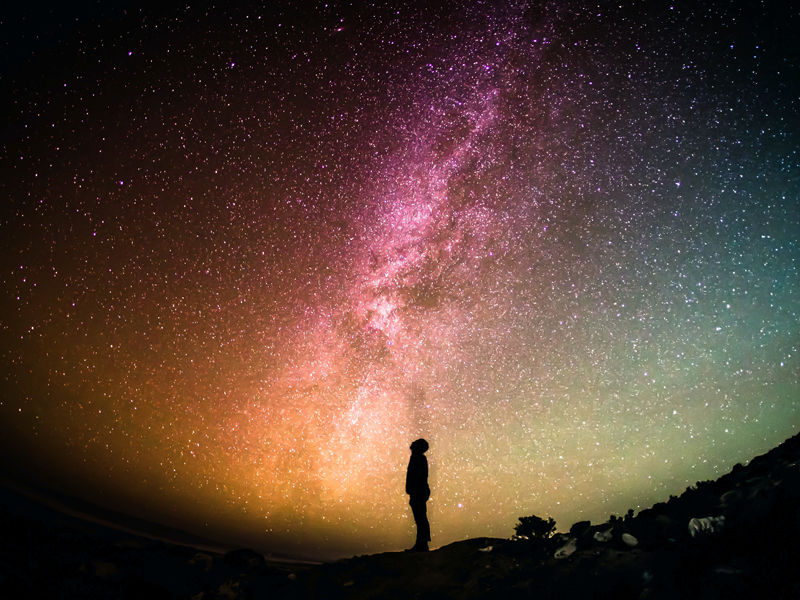By Todd Beiswenger
SpaceX made the news recently with their test launch and subsequent “rapid unscheduled disassembly” of the Starship rocket. Starship is exciting because it is probably the most realistic chance we have to finally send people to Mars, and yet, I don’t get the sense that people are particularly excited about prospect of putting people on Mars. My theory is that we just don’t have any expectation of even any hope to find life there. It was only a couple of years ago when the folks over at NASA landed their Perseverance rover on the surface of Mars. To no one’s surprise they found no little green men walking around in snazzy, shiny suits with ray guns hanging off their hips. We used to have such a great imagination for what lies in outer space! I wish there was some disappointment around NASA’s failure to find anything but red rocks, but instead there seems to be a collective shrug.
It wasn’t always this way. Back when I was a kid—and you know every good tale starts off this way—I think there was still hope that there were people, preferably, but not necessarily, green, living on Mars. There were plenty of science fiction books and movies still in popular culture in the 1970s that depicted such a reality (anybody remember the TV show My Favorite Martian?), even if that hope was squashed like one of Gallagher’s watermelons ever since the Apollo missions were unable to find life on the Moon.
Of course, this created a problem for those of us who regard the writings as more than just some good ideas, but a revelation from God. I’d say that these days there is not a more vexing book than Earths in the Universe, because nothing else in the writings is so provably wrong. This wasn’t a problem in the 1800s and most of the 1900s when followers of Swedenborg were setting up churches, groups, and societies throughout the western world. Now though, science and religion are in direct conflict!
It seemed that for a while the solution was to declare that the life described by Swedenborg was life that used to exist there, even if it isn’t there now. That position made it socially acceptable for Bryn Athyn Elementary School to have an assignment where, when I was a kid, we drew pictures of the people on the various planets in our solar system based on Swedenborg’s descriptions. I doubt they do that these days because modern science is quite clear: not only are there not people on the Moon, Mars, or any other planet in our solar system, but there’s no evidence they have ever been there! At best we can hope for is traces of some past microbial life.
Yet I just don’t buy it. I don’t think science and religion are in conflict here. I just think we need a bit more humility, and a lot more imagination. Some people might call my solution weird, and I’m sure others will suggest that when the people from the mental health institution come that I should go quietly. Maybe so, but hear me out because believe it or not, Swedenborg isn’t the only one claiming life on other planets.
Way back in 1971, a man named Robert Monroe wrote a book titled, Journeys Out of the Body. It’s a classic if you are into psychic world kind of stuff. In it he tells his own personal tale of a man with an ability that he did not ask for. He worked in the radio business, and was experimenting with, “data learning during sleep” and using himself as the number one test subject. Shortly after this he started noticing that his body would start vibrating. This started happening to him at random times, and one night he lay in bed as the vibrations began. This time he noticed that during these vibrations he could put his hand through the floor of his bedroom.
From there he learned how to leave his physical body behind and explore the world in a whole new way. He learned quickly that thought brings presence. If he was thinking about a person, he would immediately be there. Now when he visited people alive in this world, they could not see him. Eventually though he found that there were people who could see him. Some of them had already passed on from a life on Earth. Others were intelligent species from—you guessed it—other worlds.
In fairness, Monroe does not say, “I met people from Jupiter” or name any other planet in the solar system. But he does say he’s traveled the galaxy and beyond and has talked at great length with many beings that he labels as “intelligent species.” He comes to the conclusion that there are billions of different species throughout the universe. That’s right: billions. They just live on a higher frequency than we do. Just because we can’t see them doesn’t mean they’re not there.
Most people give you the “you must be crazy” look if you mention other beings that we can’t see. But really, why not? After all, we have associate spirits with us all the time that cannot see us “because nothing that is in our solar world falls into their sight” (Heaven and Hell §292). Why not beings that we can’t see? Is our imagination so limited that we can only conceive of what we see? Isn’t that the sin of Adam and Eve? They trusted their senses over what God Himself told them. I also tend to think that the Lord, the creator of the entire universe, probably has the imagination and creative juices enough to figure out how to make humans in more than just one way. If love and wisdom are the only true substances, why must we confine our thoughts of beings to those that are carbon based? Surely love and wisdom can terminate in some other, finer substance, to create life as well.
Seeing the universe this way reconciles some of the other problems created by Earths in the Universe as well, such as how could we have had beings on a gaseous planet like Jupiter and no water for the must-be-thirsty people of Mercury. We can release ourselves from the faulty idea that just because life works a certain way here that it must also work that way elsewhere too.
That said, I won’t be upset if the whole “there used to be life there” solution works for Mars. There’s still a part of me that really is hoping that a future Mars exploration will find some sort of fossilized humanoid alien skeleton with an oversized skull and antennae on its head. Maybe even the remains of a flying saucer or two. Is that really too much to ask? Perhaps I’ve let my imagination run a little too wild, but that’s because I believe with an infinite and loving God in charge that the possibilities truly are endless.
Read the full issue of the June 2023 Messenger

Meet Todd Beiswenger
Rev. Todd Beiswenger serves as the pastor for the Hurstville New Church outside of Sydney, Australia. He also has a YouTube channel called, “Lord, I’m Trying” that provides New Church interpretations of Bible stories.




